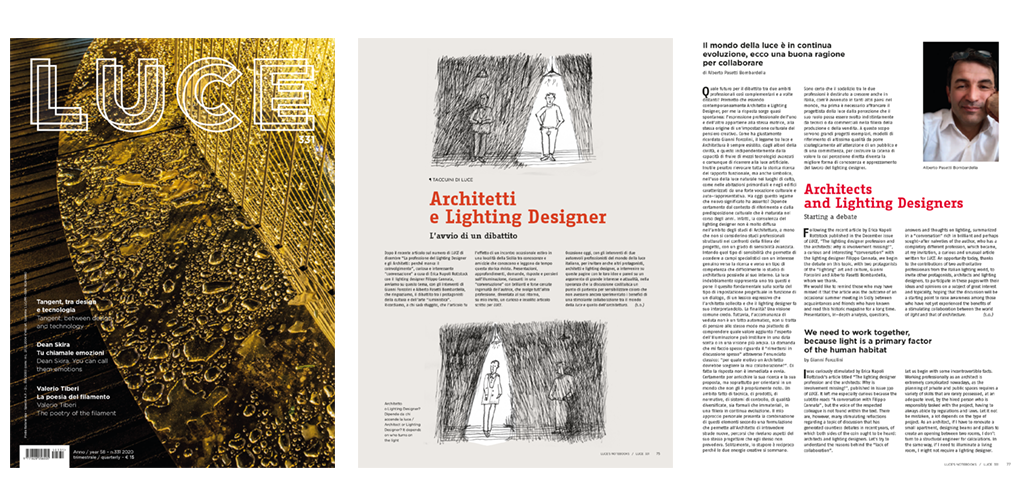ARCHITETTI E LIGHTING DESIGNER
L'AVVIO DI UN DIBATTITO
Dopo il recente articolo sul numero di LUCE di dicembre "La professione del Lighting Designer e gli Architetti: perché manca il coinvolgimento", curiosa e interessante "conversazione" a cura di Erica Napoli Rottstock con il lighting designer Filippo Cannata, avviamo su questo tema, con gli interventi di Gianni Forcolini e Alberto Pasetti Bombardella, che ringraziamo, il dibattito tra i protagonisti della cultura e dell'arte "luministica".
Ricordiamo, a chi sarà sfuggito, che l'articolo fu l'effetto di un incontro occasionale estivo in una località della Sicilia tra conoscenze e amicizie che conoscono e leggono da tempo questa storica rivista. Presentazioni, approfondimenti, domande, risposte e pensieri sull'illuminazione, riassunti in una "conversazione" con brillanti e forse cercate ingenuità dell'autrice, che svolge tutt'altra professione, diventata al suo ritorno, su mio invito, un curioso e insolito articolo scritto per LUCE.
"IL MONDO DELLA LUCE È IN CONTINUA EVOLUZIONE, ECCO UNA BUONA RAGIONE PER COLLABORARE"
Occasione oggi, con gli interventi di due autorevoli professionisti del mondo della luce italiana, per invitare anche altri protagonisti, architetti e lighting designer, a intervenire su queste pagine con le loro idee e pareri su un argomento di grande interesse e attualità, nella speranza che la discussione costituisca un punto di partenza per sensibilizzare coloro che non avessero ancora sperimentato i benefici di una stimolante collaborazione tra il mondo della luce e quello dell'architettura.
(Silvano Oldani)
LEGGI ARTICOLO
ARCHITECTS AND LINGHTING DESIGNERS
SARTING A DEBATE
Following the recent article by Erica Napoli Rottstock published in the December issue of LUCE, “The lighting designer profession and the architects: why is involvement missing?”, a curious and interesting “conversation” with the lighting designer Filippo Cannata, we begin the debate on this topic, with two protagonists of the “lighting” art and culture, Gianni Forcolini and Alberto Pasetti Bombardella, whom we thank.
We would like to remind those who may have missed it that the article was the outcome of an occasional summer meeting in Sicily between acquaintances and friends who have known and read this historic magazine for a long time. Presentations, in-depth analysis, questions, answers and thoughts on lighting, summarized in a “conversation” rich in brilliant and perhaps sought-after naiveties of the author, who has a completely different profession, which became, at my invitation, a curious and unusual article written for LUCE.
An opportunity today, thanks to the contributions of two authoritative professionals from the Italian lighting world, to invite other protagonists, architects and lighting designers, to participate in these pages with their ideas and opinions on a subject of great interest and topicality, hoping that the discussion will be a starting point to raise awareness among those who have not yet experienced the benefits of a stimulating collaboration between the world
"THE WORLD OF LIGHT IS CONSTANTLY EVOLVING, HERE IS A GOOD REASON TO COLLABORATE"
Iwas curiously stimulated by Erica Napoli Rottstock's article titled "The lighting designer profession and the architects: Why is involvement missing?", published in issue 330 of LUCE.
It left me especially curious because the subtitle reads "A conversation with Filippo Cannata", but the voice of the respected colleague is not found within the text. There are, however, many stimulating reflections regarding a topic of discussion that has generated countless debates in recent years, of which both sides of the coin ought to be heard: architects and lighting designers. Let's try to understand the reasons behind the "lack of collaboration".
Let us begin with some incontrovertible facts. Working professionally as an architect is extremely complicated nowadays, as the planning of private and public spaces requires a variety of skills that are rarely possessed, at an adequate level, by the hired person who is responsibly tasked with the project, having to always abide by regulations and laws. Let it not be mistaken, a lot depends on the type of project. As an architect, if I have to renovate a small apartment, designing beams and pillars to create an opening between two rooms, I don't turn to a structural engineer for calculations. In the same way, if I need to illuminate a living room, I might not require a lighting designer.
Of light and that of architecture. (Silvano Oldani)
READ TEXT


